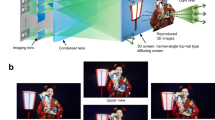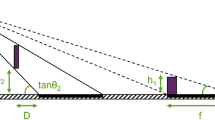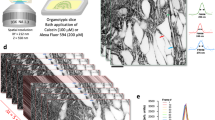Abstract
THE following simple arrangement makes it possible to project, in stereoscopic depth, three-dimensional objects such as wire models of molecular or crystal structures. Small models may be presented enlarged in three dimensions, magnifications of ten or more times being possible. The optical arrangement consists of nothing but a pair of small bright light sources, separated horizontally by a few inches. The sources are placed behind ‘Polaroid filters’, set at orientations differing by 90°. The point polarized sources give a pair of shadow images of an object, such as a wire model, placed between them and a silver screen. Alternatively, back-projection with a ground-glass screen can be used; but the screen must not de-polarize the light. When the shadows are viewed through crossed ‘Polaroid’ glasses, they are fused by the brain to form a single stereoscopic shadow-image lying in space.
This is a preview of subscription content, access via your institution
Access options
Subscribe to this journal
Receive 51 print issues and online access
$199.00 per year
only $3.90 per issue
Buy this article
- Purchase on Springer Link
- Instant access to full article PDF
Prices may be subject to local taxes which are calculated during checkout
Similar content being viewed by others
Author information
Authors and Affiliations
Rights and permissions
About this article
Cite this article
GREGORY, R. Stereoscopic Shadow-images. Nature 203, 1407–1408 (1964). https://doi.org/10.1038/2031407b0
Issue Date:
DOI: https://doi.org/10.1038/2031407b0
This article is cited by
-
The largest convex patches: A boundary-based method for obtaining object parts
Biological Cybernetics (1990)
-
Stereoscopic Vision in the Cat
Nature (1971)
Comments
By submitting a comment you agree to abide by our Terms and Community Guidelines. If you find something abusive or that does not comply with our terms or guidelines please flag it as inappropriate.



